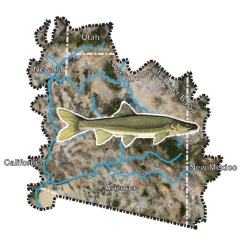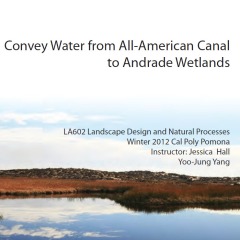When the River is Client
March 16, 2012 § 1 Comment
“The river as plaintiff speaks for the ecological unit of life that is part of it.”
– Justice William O. Douglas
For one academic quarter, second year graduate landscape design students at Cal Poly Pomona tackled the issues of the Lower Colorado River. Over five weeks, students took on roles as consulting experts, studying different aspects of the river system, the ways the river’s bounty is used, impacts, and issues facing its ecosystem. Lectures and field trips highlighted ecosystem functions and approaches to restore degraded or disturbed functions. Some of the findings from field trips are recorded at L.A. Creek Freak. With the river’s flows overallocated, it is no surprise that the lack of flows reaching the Colorado Delta in Mexico and lack of flood regime for overall ecosystem health ranked high among recommendations to restore ecosystem function. Other significant issues noted were water and soil quality impacts from agricultural runoff, sediment retention behind dams, and uranium deposits in sediment. The effects of this resulting in diminished bird and fish species were a particular concern.
With the River as their Client, students were then challenged to propose designs or policies that took either long-term of short-term approaches to returning ecosystem function back to the River. These solutions are presented here – a laboratory of ideas ranging from big picture solutions that require some political tangoing to manifest to quickly implementable habitat life-lines and public awareness/access projects. Projects are presented topically, from Big Visions, then descending geographically and topically from the top of Lower Colorado Basin watershed down to the US Border. Taken together, the projects can comprise a nice Master Plan for resolving this critical contemporary environmental issue on the U.S. side of the border (apologies to Mexico!). PDF’s of the students projects are hyperlinked – check it out!
Big Visions
 2045: A River Odyssey uses the frame of science-fiction story-telling to envision a society capable of coming to terms with a wild and natural Colorado River, in which a culture of River Journeymen team with ecologists and administrators, moving up the river as they restore it with ephemeral encampments and low-impact desert-suitable permaculture. The Design Team of Johnathan Perisho + Michael Plansky were inspired by not only Stanley Kubrick’s vision of humanity revisiting technological development but also Bunker Roy’s Barefoot College, and Aldo Leopold’s ecological sensibility, and a sensitivity to the inclusion of homeless riverside campers as stakeholders, among other influences.
2045: A River Odyssey uses the frame of science-fiction story-telling to envision a society capable of coming to terms with a wild and natural Colorado River, in which a culture of River Journeymen team with ecologists and administrators, moving up the river as they restore it with ephemeral encampments and low-impact desert-suitable permaculture. The Design Team of Johnathan Perisho + Michael Plansky were inspired by not only Stanley Kubrick’s vision of humanity revisiting technological development but also Bunker Roy’s Barefoot College, and Aldo Leopold’s ecological sensibility, and a sensitivity to the inclusion of homeless riverside campers as stakeholders, among other influences.
 1% For the River follows the findings of the Sonoran Institute and others, that an increase in 1% flows for the Colorado River would sustain the delta ecosystem. Calculating water use in agricultural and urban areas throughout the Lower Basin states (Arizona, Nevada, and California), this project identifies 1% in retiring a small area of subsidized farmland and converting urban and suburban lawns into a mix of native and edible gardens. Designer: Viviana Rodriguez
1% For the River follows the findings of the Sonoran Institute and others, that an increase in 1% flows for the Colorado River would sustain the delta ecosystem. Calculating water use in agricultural and urban areas throughout the Lower Basin states (Arizona, Nevada, and California), this project identifies 1% in retiring a small area of subsidized farmland and converting urban and suburban lawns into a mix of native and edible gardens. Designer: Viviana Rodriguez
Reimagining Lower Colorado Agriculture assesses agricultural practices in the Imperial Valley, from the standpoint of subsidies, exported virtual water, and caloric/nutritional value – proposing an alternative agricultural scheme that provides a significant increase in flows to the Colorado River and Delta, offering higher nutrition desert native or desert-tolerant crops and an approach to farming with the natural cycles of rainfall and flood. Designer: James Powell
Sediment Transport
 True Reclamation – the “de-reclamation” of Glen Canyon Dam documents the sedimentation behind Glen Canyon Dam, and, in acknowledgement of the decades of uranium washing in with the sediment, proposes a long-term phytoremediation and habitat restoration scheme as the water level is gradually lowered and sediment is sluiced through the dam’s diversion tunnels, restoring habitat and functionality through the Grand Canyon. Designer: Eric Haley
True Reclamation – the “de-reclamation” of Glen Canyon Dam documents the sedimentation behind Glen Canyon Dam, and, in acknowledgement of the decades of uranium washing in with the sediment, proposes a long-term phytoremediation and habitat restoration scheme as the water level is gradually lowered and sediment is sluiced through the dam’s diversion tunnels, restoring habitat and functionality through the Grand Canyon. Designer: Eric Haley
Making Tracks addresses the legacy of uranium mining on the Navajo Reservation, its impact on the Little Colorado River and Moenkopi Wash – both tributaries of the Colorado River. Focusing on phytoremediation and desert-appropriate urban forestry strategies, this project mitigates uranium-laced runoff from old mine sites and the effects of airborne particulates (including uranium) from wind and dust storms that are resulting in sand dunes engulfing structures. Designer: Tiernan Doyle
Off-Channel Habitat Enhancement
 Colorado Pikeminnow Nurseries delivers what its title promises – a lifeline for a once-plentiful, large fish that has been completely extirpated from the Colorado River – confined today to only a relatively small reach of the Green River. The project makes use of abandoned meanders of the pre-channelized River, offering trails and interpretation along the nursery. The nursery is also graded to mimic geomorphic features of the fish’s natural habitat. Project Designer Devon Santy focused on this particular species because no recovery plans in the Colorado River currently exist.
Colorado Pikeminnow Nurseries delivers what its title promises – a lifeline for a once-plentiful, large fish that has been completely extirpated from the Colorado River – confined today to only a relatively small reach of the Green River. The project makes use of abandoned meanders of the pre-channelized River, offering trails and interpretation along the nursery. The nursery is also graded to mimic geomorphic features of the fish’s natural habitat. Project Designer Devon Santy focused on this particular species because no recovery plans in the Colorado River currently exist.
 Oxbow Lake takes a cue from the restoration strategy of Fred Phillips at the Yuma East Wetlands and Natural Channel Design at the Laguna Wetlands, in which stop-log weirs hold waters in cells to maintain wetland habitats. The Oxbow lake is an existing site, an apparent abandoned meander of the Colorado River, revisioned here as more highly functioning habitat with biotic diversity along its vertical canopy. Project Designer: Katya Khankhalaeva.
Oxbow Lake takes a cue from the restoration strategy of Fred Phillips at the Yuma East Wetlands and Natural Channel Design at the Laguna Wetlands, in which stop-log weirs hold waters in cells to maintain wetland habitats. The Oxbow lake is an existing site, an apparent abandoned meander of the Colorado River, revisioned here as more highly functioning habitat with biotic diversity along its vertical canopy. Project Designer: Katya Khankhalaeva.
Human Habitats: Public Access with Conservation Ethics
Braiding Bullhead examines the opportunity for a regional park along the Colorado River, preserving desert wash tributaries, mesas and desert scrub habitat while tying into an existing greenway plan trail network and enhancing wetland habitat along the river’s edge. The plan provides wetland enhancements along the river and boat access for the human residents of Bullhead City, with programming for day and evening activities. Project Team: Katie Klein and Mallory Piazzola
Human Nature Interface: Balancing Habitats along the Colorado River Corridor converts underutilized parcels at the intersection of the 10 Freeway and Colorado River into visitor’s center/nature park/trail destination for locals and long-distance road-trippers, enhancing the visibility of the river at the 10 Freeway crossing. A dramatic pedestrian bridge over the 10 Freeway is intended to capture the imagination of passers-by, the commanding view from the bridge heightens the viewer’s understanding of the river as a regional resource. Wetland restorations build on the protocols of the Multi-Species Recovery Plan. Project Designer: Michael Russell
 Reducing Water from External Sources: Pershing Square demonstrates the impact – or savings – that urban areas can have on Colorado River (and Bay Delta) resources. Providing a history of Pershing Square, Project Designer Laura Razo explores the water budget of its current design and proposes a new design with stormwater capture and biofiltration treatment, and improvements in drought tolerant planting and site design – reserving water to be returned to the Colorado River.
Reducing Water from External Sources: Pershing Square demonstrates the impact – or savings – that urban areas can have on Colorado River (and Bay Delta) resources. Providing a history of Pershing Square, Project Designer Laura Razo explores the water budget of its current design and proposes a new design with stormwater capture and biofiltration treatment, and improvements in drought tolerant planting and site design – reserving water to be returned to the Colorado River.
Salton Sea and Tribs
New River Delta Remediation looks at this highly contaminated tributary to the Salton Sea. The New River, and the paralleling Alamo River flow north from Mexico, carrying agricultural and sewage waste. Invasive species dominate the river’s banks. The project proposes restoration and phytoremediation of agricultural runoff and wetland restoration at the Salton Sea, an important bird destination along the Pacific Flyway. Project Designer: Tom Gage
Salton Sea Rehabilitation – Rebuilidng a Critical Avian Ecosystem observes that when it comes to lakes, it isn’t the size that matters, but the overall health, temperature, and circulation of its water. Acknowledging the inexorable and inevitable decline of the Salton Sea, this project proposes strategies to maintain the sea as a precious resource along the Pacific Flyway, using desalting, resizing of the lake, and phytoremediation as design strategies. Project Designer: Alex Fagnan
Multi-Functional Irrigation Canals
 Convey Water from All-American Canal to Andrade Wetlands revisits the efficiency-based decision of American water suppliers to prevent the loss of canal water to groundwater seepage, seepage that was maintaining the Andrade Wetlands in Mexico. These incidental wetlands had become an important migratory bird stop on the Pacific Flyway. Project Designer Yoo Jung Yang found that losses by groundwater seepage could be balanced by mitigating evaporation-based losses, with other exciting gains such as solar energy and trails. Cover photograph by artist Cynthia Hooper.
Convey Water from All-American Canal to Andrade Wetlands revisits the efficiency-based decision of American water suppliers to prevent the loss of canal water to groundwater seepage, seepage that was maintaining the Andrade Wetlands in Mexico. These incidental wetlands had become an important migratory bird stop on the Pacific Flyway. Project Designer Yoo Jung Yang found that losses by groundwater seepage could be balanced by mitigating evaporation-based losses, with other exciting gains such as solar energy and trails. Cover photograph by artist Cynthia Hooper.
 Irrigation Canal Remediation Project proposes a restoration approach to phytoremediation of agricultural wastewater that sustains the Cienega de Santa Clara in Mexico. With the intention of maintaining discharges to the Cienega, Project Designer Roxana Marashi creates a wet meadow to remediate agricultural toxins and establish habitat at a site near the US-Mexico border.
Irrigation Canal Remediation Project proposes a restoration approach to phytoremediation of agricultural wastewater that sustains the Cienega de Santa Clara in Mexico. With the intention of maintaining discharges to the Cienega, Project Designer Roxana Marashi creates a wet meadow to remediate agricultural toxins and establish habitat at a site near the US-Mexico border.






